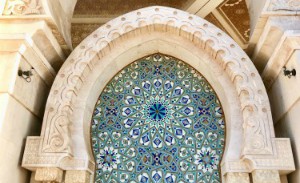By Susan Robertson, Class of 2009
Photos by the author
Brent Hoffmann and I traveled to Morocco in January, and here are a few CAF audience-oriented highlights:

Meet at Rick’s Cafe
“Don’t forget to visit Rick’s Café.” That’s what we heard from everyone who learned we were traveling to Casablanca. In the 1942 movie, Rick (Humphrey Bogart) says, “I came to Casablanca for the waters.” His questioner replies, “The waters? What waters? We’re in the desert!” In fact, Casablanca is a coastal city with boulevards lined with orange trees and walls covered with pink flowering bougainvillea. However, the film “Casablanca” was created in a Hollywood studio; in 1942, there was no Rick’s Café anywhere in Morocco. In 2004, a clever American, Kathy Kriger, opened an atmospheric Art Deco version of Rick’s Café. It’s worth a visit (reserve ahead), and it’s just a short walk from the Hassan II Mosque.
Don’t Miss the Modern Architecture
We’re docents: modern architecture drew our attention.

Hassan II Mosque in Casablanca is located on the edge of the Atlantic Ocean. Designed by French architect Michel Pinseau, crafted with ancient techniques, and completed in 1993. More than 10,000 artisans worked for seven years to create this monumental building. It showcases Moroccan materials: marble, hand-painted cedarwood ceilings, plaster moldings with intricate patterns, and “zellige” mosaics with intense color and beautiful geometric patterns (see below). The Hassan II Mosque is the largest mosque outside Saudi Arabia, with interior prayer space for 25,000 and room for another 80,000 in the grand plaza outside. Its minaret is the tallest in the world, topped by a laser light that shines in the evening toward Mecca.

Casarts Theater in Casablanca, soon to be the largest theater in Africa, is centered on Mohammed V Plaza. It is currently under construction. The exterior shines bright with white trapezoidal forms; completion is expected in late 2018. It was designed by the Paris-based architect, Christian de Portzamparc, who was born in Casablanca while his father served in the French Army. In 1994, Porzamparc was the first French architect to win the Pritzker Architecture Prize; he was cited as “a powerful poet of forms and creator of eloquent spaces.”

Yves Saint Laurent Museum in Marrakesh, designed by Studio KO (Karl Fournier and Olivier Marty, Paris), was just completed. It was selected by Architectural Digest as one of the world’s 11 best buildings of 2017. The museum’s exterior walls have a pink granite base topped by local reddish-brown terra cotta bricks set in patterns reminiscent of the warp and weft of fabric — a deliberate gesture to acknowledge the work of Saint Laurent. The exhibitions of haute couture inside are splendid. Adjacent to the museum is the Jardin Majorelle, a lush cactus and palm garden created in the 1920s and restored by Saint Laurent in 1980.
Walk in a World Heritage Pedway
Fez, the former capital of Morocco, was founded in the 9th century. The city is nestled in a valley surrounded by the Middle Atlas Mountains. “Medina” means “old walled city.” The Fez El-Bali Medina is preserved as a UNESCO World Heritage Site because it offers “an outstanding example of a medieval city.” The Fez Medina – with an estimated 150,000 residents – is still fully functional. It has shops, bazaars, universities, mosques, and riads (homes with interior sky-lit courtyards). Thousands of craftsmen ply their trades within the city – leatherworkers, coppersmiths, weavers, potters – creating a beehive of medieval activity. Inside the medina walls there are no cars. Pedestrians are confronted with a confusing labyrinth of narrow twisting alleys.
It is easy to get lost, so hiring a guide is a prudent precaution. With our guide, we walked five miles through this ancient pedway system. Author Edith Wharton traveled to Fez in 1918 and she wrote, “The distances in Fez are so great and the streets so narrow…that all but saints or humble folk go about on mule-back.” Today, the donkeys and mules (there are many) are reserved for carrying goods, not people. In the souks we encountered spice sellers, date and dried fruit shops, camel butchers, bakers, pastry shops, and souvenirs of every sort from rare antiques to leather slippers. Most astonishing were ancient leather tanneries, right in the middle of the old city. Leather shopkeepers invite
you for a fourth-floor balcony view of the tanneries, with shopping nonstop as you descend. Be warned: the tanneries reek of ammonia. The leather curing pits are filled with limestone, pigeon excrement, and water. Staff guides offer you a bouquet of mint to ameliorate your smelling experience.

Find Acanthus Leaves at the Far Reaches of the Roman Empire
About an hour from Fez is another UNESCO World Heritage Site, the ruins of Volubilis. During the 2nd and 3rd centuries AD, this ancient city was the capital of “Mauritania Tingitana,” the northeast part of Africa conquered by the Romans. Volubilis was an olive oil production center within the Roman Empire, and it is still surrounded by olive groves. Wealthy oil merchants built homes with stunning mosaic floors, many of which remain. Most of the walls in Volubilis collapsed from the massive Lisbon Earthquake of 1755. We were pleased to find a number of restored columns with acanthus leaves on their capitals, as well as native acanthus plants nearby. We learned that the acanthus, a spikey-leafed weed, grows throughout the Mediterranean.
Art Deco, too
Casablanca has a magnificent collection of Art Deco buildings, though many are in sad repair. Each of the one-time capitals of Morocco, known as the “Four Royal Cities” — Rabat, Marrakesh, Meknes and Fez — has many splendid old buildings in the Moroccan style. Also, should your travels take you to Morocco, don’t miss the modern architecture.




Thank you for sharing! I’d love to go someday…